Error processing SSI file
Story Ideas - 2012
- January
- February
- March
- April
- May
- June
- July
- August
- September
- http://www.cdc.gov/media/storyideas/2012.html
- http://www.cdc.gov/media/storyideas/2012.html
- http://www.cdc.gov/media/storyideas/2012.html
Jan
National Folic Acid Awareness Week January 8th-14th: What should you know about folic acid?

Folic acid is a B vitamin that is used by the body to make new cells. Everyone needs folic acid! If a woman has enough folic acid in her body before and during pregnancy, it can help prevent major birth defects of the baby’s brain and spine. CDC urges women to take 400 mcg of folic acid every day, starting at least one month before getting pregnant, to help prevent major birth defects. There are two easy ways to be sure to get enough folic acid each day:
- Take a vitamin that has folic acid in it every day.
Most multivitamins sold in the United States have the amount of folic acid women need each day. Women can also choose to take a small pill (supplement) that has only folic acid in it each day. Multivitamins and folic acid pills can be found at most local pharmacy, grocery, or discount stores. Check the label to be sure it contains 100% of the daily value (DV) of folic acid, which is 400 micrograms (mcg). - Eat a bowl of breakfast cereal that has 100% of the daily value of folic acid every day.
Not every cereal has this amount. Check the label on the side of the box, and look for one that has “100%” next to folic acid.
Related Links:
Did you know January is National Glaucoma Awareness Month? Here are some eye health tips to share with your readers

Glaucoma is a group of diseases that can damage the eye's optic nerve and result in vision loss and blindness. Glaucoma occurs when the normal fluid pressure inside the eyes slowly rises. However, recent findings now show that glaucoma can occur with normal eye pressure. With early detection and timely treatment, you can often protect your eyes against serious vision loss. Your eyes are an important part of your health. You can do many things to keep them healthy and make sure you’re seeing your best. Please share the following simple guidelines with your readers for maintaining healthy eyes well into their golden years:
- Have a comprehensive dilated eye exam. You might think your vision is fine or that your eyes are healthy, but visiting your eye care professional for a comprehensive dilated eye exam is the only way to really be sure. Regular eye exams are important for good eye health as well as overall health. A comprehensive dilated eye exam is a painless procedure in which an eye care professional examines the eyes to look for common vision problems and eye diseases, many of which have no early warning signs.
- Know your family’s eye health history. Talk to your family members about their eye health history. It’s important to know if anyone has been diagnosed with an eye disease or condition, since many are hereditary.
- Eat right to protect your sight. You’ve heard that carrots are good for your eyes. But eating a diet rich in fruits and vegetables—particularly dark leafy greens, such as spinach, kale, or collard greens—is important for keeping your eyes healthy, too.
- Quit smoking or never start.
- Maintain a healthy weight. Being overweight or obese increases your risk of developing diabetes and other systemic conditions, which can lead to vision loss, such as diabetic eye disease or glaucoma (Diabetic eye disease refers to various eye problems that may occur as a complication of diabetes, including diabetic retinopathy, glaucoma, and cataract. These conditions can lead to vision loss and blindness).
- Wear protective eyewear. Wear protective eyewear when playing sports or doing activities around the home.
- Give your eyes a rest. If you spend a lot of time at the computer or focusing on any one thing, you sometimes forget to blink and your eyes can get fatigued. Try the 20-20-20 rule: Every 20 minutes, look away about 20 feet in front of you for 20 seconds. This short exercise can help reduce eyestrain.
- Practice workplace eye safety. Employers are required to provide a safe work environment. When protective eyewear is required as a part of your job, make a habit of wearing the appropriate type at all times, and encourage your coworkers to do the same.
Related Links:
Understanding your health shouldn’t be a puzzle: Why you should ask for plain language in healthcare

Let’s face it: managing your health can be complicated. Every day, we face situations that involve life-changing decisions about our health. Research shows that today's health information is hard to understand and use to make good decisions. But health information and services don’t have to be so complicated. It helps to be a savvy consumer. How can you get the most from health information and services?
First, know the law. As of this year, federal government agencies must use plain language when they communicate with the public about critical benefits and services. If you find federal government health information that isn’t in plain language, you can contact that agency and ask them to make it clear.
Second, clear communication is part of the Patient Protection and Affordable Care Act, i.e. "health reform," the most significant change to health policy in decades. Soon, health insurance companies will be required to tell you about coverage and benefits in plain language. You may also find “patient navigators,” people who can help you find your way through the maze of healthcare.
Third, when you go to the doctor, clinic or hospital, ask them to use plain language when they talk to you and ask for plain language patient information. You can take a list of questions and ask for clear answers and explanations.
Why is health literacy important?
- Nearly 9 out of 10 adults have difficulty using the everyday health information that is routinely available in our healthcare facilities, retail outlets, media and communities.
- Without clear information and an understanding of the information's importance, people are more likely to skip necessary medical tests, end up in the emergency room more often, and have a harder time managing chronic diseases like diabetes or high blood pressure.
Inform your readers on becoming more health literate and visit the CDC website for training resources, materials and more for your state.
Related Links:
Feb
Keep Your Heart Healthy in February

The term "heart disease" refers to several types of heart conditions. The most common type in the United States is coronary artery disease, which can cause heart attack, angina, heart failure, and arrhythmias.
The major signs and symptoms of a heart attack are—
- Pain or discomfort in the jaw, neck, or back.
- Feeling weak, light-headed, or faint.
- Chest pain or discomfort.
- Pain or discomfort in arms or shoulder.
- Shortness of breath.
If you think that you or someone you know is having a heart attack, you should call 9–1–1 immediately.
If the blood supply to the heart muscle is cut off, a heart attack can result. Cells in the heart muscle do not receive enough oxygen and begin to die. The more time that passes without treatment to restore blood flow, the greater the damage to the heart. Having high blood pressure or high blood cholesterol, smoking or exposure to secondhand smoke, physical inactivity, family history, and having had a previous heart attack, stroke, or diabetes can increase a person's chances of having a heart attack. You can also take steps to reduce your risks for heart attack; learn the ABCS at Million Hearts.
It is important to recognize the signs of a heart attack and to act immediately by calling 9–1–1. A person's chances of surviving a heart attack are increased if emergency treatment is given to the victim as soon as possible.
Related Links:
Time to Brush Your Teeth

Tooth decay (cavities) is one of the most common chronic diseases of children in the United States. Untreated tooth decay causes pain and infections that may lead to problems―such as with eating, speaking, playing, and learning. The good news is that tooth decay is preventable. The combination of fluorides and dental sealants has the potential to nearly eliminate tooth decay in children.
Here are some things you can do to ensure good oral health for your child:
- Protect your child’s teeth with fluoride.
- Begin using a fluoride toothpaste when your child is 2 years old. If your child is younger than 6 years old, put only a pea-sized amount on their toothbrush. Supervise your child’s tooth brushing, encouraging the child to spit out toothpaste rather than swallow it. Additional information is available online: http://www.cdc.gov/oralhealth/publications/factsheets/brushup.htm.
- If your drinking water is not fluoridated, talk to a dentist or physician about the best way to protect your child’s teeth.
- Talk to your child’s dentist about dental sealants. They protect the chewing surfaces of the back teeth from decay.
- Encourage your children to eat regular nutritious meals, avoid frequent between-meal snacking, and limit sugar-sweetened beverages.
- If you are pregnant, get prenatal care and eat a healthy diet. The diet should include folic acid to prevent birth defects of the brain and spinal cord and possibly cleft lip/palate.
Related Links
Healthy Valentine's Day

Plan Your Valentine's Day with healthy choices in mind. Whether you plan to celebrate on your own or with someone special, have a safe and healthy Valentine’s Day. Take steps to be a healthy valentine. Challenge yourself to be active, healthy, and smoke free. Use these tips to give the gift of health to yourself and loved ones on Valentine’s Day and all year long.
- Treat yourself and loved ones to a heart-healthy meal that includes plenty of fruits and vegetables and foods low in saturated fat and salt.
- Plan an event that encourages physical activity, and healthy eating.
- Give yourself or your loved ones a favorite healthy alternative to candy.
- If you smoke, quit smoking. It's a perfect gift for yourself and others.
- February is American Heart Month. Help raise awareness about heart disease prevention. Encourage yourself and others to learn about how to lower heart disease risk and take action!
- Learn the most common symptoms of a heart attack. Call 9-1-1 immediately if these symptoms arise.
Related Links
You Just Had a Baby! (Parenting Tips for Newborns)

The early years of a child’s life are very important for his or her health and development. Healthy development means that children of all abilities, including those with special health care needs, are able to grow up where their social, emotional and educational needs are met. Having a safe and loving home and spending time with family―playing, singing, reading, and talking―are very important. Proper nutrition, exercise, and rest also can make a big difference.
Here are some tips you, as a parent, can do to help your baby during this time:
- Talk to your baby. She will find your voice calming.
- Answer when your baby makes sounds by repeating the sounds and adding words. This will help him learn to use language.
- Read to your baby. This will help her develop and understand language and sounds.
- Sing to your baby and play music. This will help your baby develop a love for music and will help his brain development.
- Praise your baby and give her lots of loving attention.
- Spend time cuddling and holding your baby. This will help him feel cared for and secure.
- Play with your baby when she’s alert and relaxed. Watch your baby closely for signs of being tired or fussy so that she can take a break from playing.
- Distract your baby with toys and move him to safe areas when he starts moving and touching things that he shouldn’t touch.
- Take care of yourself physically, mentally, and emotionally. Parenting can be hard work! It is easier to enjoy your new baby and be a positive, loving parent when you are feeling good yourself.
Related Links
Mar
National Women and Girls HIV/AIDS Awareness Day

Share with your readers that March 10, 2012 is National Women and Girls HIV/AIDS Awareness Day! This day serves to recognize the special risks HIV/AIDS poses for women and girls, and to raise awareness of the disease's increasing impact on them. In 2009, nearly a quarter of diagnoses of HIV infection in the United States were among women and girls aged 13 years and older. Women and girls of color—especially African American women and girls—bear a disproportionately heavy burden of HIV infection. In 2009, black women accounted for nearly 60 percent of all new HIV infections among women with an HIV infection rate 15 times higher than white women. Hispanic women are also disproportionately affected with an HIV infection rate more than four times as high as white women.
The reason women of color are more severely burdened by HIV and AIDS is not directly related to race or ethnicity, but rather to some of the barriers faced by many in these communities across the country. The harsh reality is that even with similar levels of individual risk behaviors as women of other races, a range of factors place these women at greater risk for HIV (e.g. greater prevalence of HIV within communities, lack of access to healthcare, stigma, fear and misinformation). To end this epidemic, we must confront the Social and environmental factors that continue to place these women and girls at greater risk of contracting HIV.
On March 8, and in conjunction with National Women and Girls HIV/AIDS Awareness Day, CDC is launching a new HIV testing and awareness campaign for African American women called Take Charge. Take the Test. to help combat the particularly heavy burden of HIV in this population. This campaign reminds African American women that they have the power to take charge of their health, by learning their HIV status and protecting themselves against HIV. Take Charge. Take the Test will launch both nationally and in 10 metro areas where black women are hard hit by HIV. Thisis the latest campaign of Act Against AIDS, CDC’s umbrella campaign to fight complacency about HIV nationwide. For more information, visit www.hivtest.org/takecharge.
What can your readers do?
- Get tested for HIV. To find a testing site center near you, text your ZIP Code to KNOW IT (566948).
- Talk with your health care provider about your risks for HIV.
- Get the facts about HIV/AIDS by visiting the Act Against AIDS web site including:
- The risk factors for acquiring HIV.
- How to avoid high-risk behaviors.
- How to practice safer methods to prevent HIV.
- Talk about HIV prevention with family, friends, and colleagues.
- Volunteer at a local organization that serves people living with HIV.
- Attend an event near you.
- Learn more about the impact of HIV/AIDS among women in the United States.
- Stand up against stigma, racism, and other forms of discrimination associated with HIV/AIDS.
- Donate time and money to HIV/AIDS organizations.
For more information on this day, theme, and events please visit the U.S. Department of Health and Human Services, Office on Women's Health, which is leading activities for this observance.
Related Links:
World Tuberculosis Day 2012: “Stop TB in my lifetime”
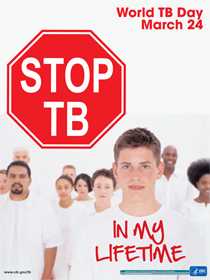
Each year, we recognize World TB Day on March 24, often with a variety of activities leading up to the official day. This annual event commemorates the date in 1882 when Dr. Robert Koch announced his discovery of Mycobacterium tuberculosis, the bacillus that causes tuberculosis (TB). TB is one of the world’s deadliest diseases: One third of the world’s population is infected with TB, in 2010, nearly 9 million people around the world became sick with TB, and, there were around 1.45 million TB-related deaths worldwide. TB is a leading killer of people who are HIV infected.
World TB Day provides an opportunity to raise awareness about TB-related problems and solutions, and to support worldwide TB-control efforts. CDC and our partners are committed to a world free of TB. In their lifetimes, today's children should expect to see a world where no one gets sick with TB. In their lifetimes, women and men should expect to see a world where no one dies from TB. All of us can have different hopes, such as for faster treatment; a quick, cheap, low-tech test that is accessible to all; or an effective vaccine.
Share with your readers how they can become a partner in the Fight Against TB:
- Find out more about TB services in your area.
- Reach out to your community and educate them about TB.
Because many people are not aware of the impact of TB, local coalitions in many states and countries are convening educational and awareness activities related to World TB Day. Encourage your readers to learn more and get involved.
Related links:
Winnable Battles towards "Health Protection…Health Equity"

To keep pace with emerging public health challenges and to address the leading causes of death and disability, CDC initiated an effort to achieve measurable impact quickly in a few targeted areas. CDC's Winnable Battles are public health priorities with large-scale impact on health and with known, effective strategies to address them.
The current Winnable Battles have been chosen based on the magnitude of the health problems and our ability to make significant progress in improving outcomes. By identifying priority strategies and clear targets and by working closely with our public health partners, we can make significant progress in reducing health disparities and the overall health burden from these diseases and conditions.
Encourage your readers to learn more about CDC's goals for the Winnable Battles initiative, what CDC is doing, and what they can do to support.
Winnable Battle Areas:
- Food Safety
- Global Immunization
- Healthcare-associated Infections
- HIV in the U.S.
- Lymphatic Filariasis in the Americas
- Motor Vehicle Injuries
- Nutrition, Physical Activity, and Obesity
- Mother-to-Child Transmission of HIV and Syphilis Globally
- Teen Pregnancy
- Tobacco
Related links:
Apr
Staying Safe on Prom Night

For many people, prom is one of the highlights of the high school experience. Whether you're going solo or with a date or group, trying new or different activities, or staying out late, being responsible is key for a safe and healthy prom night. Smart decisions may also help lower stress while planning and enjoying the big night.
Follow these tips for a safe and healthy prom to ensure everyone has a great time:
- Get in shape slowly and wisely. Eat healthy and be active.
- Protect yourself from the harmful effects of UV rays. Avoid indoor and outdoor tanning, and use a sunscreen with an SPF of 15 or higher.
- Test all cosmetics and hair dyes before using them. Follow the directions and read any cautions and warnings on labels carefully.
- Be stylish and safe by wearing comfortable shoes and attire to prevent injury.
- Watch your budget. Have fun without spending a lot of money and causing unneeded stress.
- Say no to alcohol, smoking, drugs, and sex.
- Don't drink and drive, and don't get in a car with anyone who has been drinking.
- Call a parent, guardian, or someone you trust in case plans change or you need help.
- Many teens do not report teen dating violence because they are afraid to tell friends and family. Tell a family member or call 911 if you or someone you know is being abused. Call a parent, guardian, or someone you trust in case plans change or you need help.
Going to prom is an exciting event! Make sure your evening is fun, safe, and healthy!
Related Links:
Binge Drinking and Women’s Health: Alcohol Awareness Month

April marks Alcohol Awareness Month, a nationwide health observance intended to raise awareness of the health and social problems that excessive alcohol consumption can cause for individuals, their families, and their communities. Excessive drinking is a dangerous behavior for both men and women.
Binge drinking is defined as consuming four or more drinks per occasion for women and five or more drinks per occasion for men. It is a common and dangerous behavior that contributes to more than 11,500 deaths among women in the U.S. each year—approximately 32 deaths per day. In 2010, more than one out of every 10 women reported binge drinking during the past 30 days. On average, women who binge drink said they engaged in this risky behavior at least three times per month and they consume on average of 6 drinks on occasion. Binge drinking usually leads to impairment, and women who binge drink with greater frequency and intensity put themselves and those around them at increased risk of experiencing alcohol-related harms, particularly if they are pregnant or may become pregnant. Binge drinking increases the risk for breast cancer, heart disease, and stroke, all of which are leading causes of death in women.
Binge drinking and the harms that result from it can be prevented.
All Women Can:
- Avoid drinking alcohol if pregnant or planning to become pregnant. Remember—Fetal Alcohol Spectrum Disorders are 100% preventable.
- Choose not to binge drink and help others not to do it. Binge drinking leads to many health and social problems for the drinkers, their families, and their communities. If women choose to drink alcoholic beverages, they should do so in moderation - defined as the consumption of up to one drink per day for women and up to two drinks per day for men, according to the 2010 Dietary Guidelines for Americans.
- Seek care from a health care provider for excessive drinking. The U.S. Preventive Services Task Force recommends screening and behavioral counseling for alcohol misuse by adults, including pregnant women. Screening and Brief Intervention has been shown to significantly decrease the number of drinks consumed per week and the number of binge drinking episodes.
Related Links:
Be Aware of Sexual Assault

In the United States, 1 in 6 women and 1 in 33 men report that they have experienced an attempted or completed rape in their lifetime. April is Sexual Assault Awareness Month and an opportune time to remind readers about this serious public health problem.
Sexual violence is any sexual activity where consent is not freely given. This includes completed or attempted sex acts that are against the victim’s will or involve a victim who is unable to consent. It also includes abusive sexual contact and noncontact sexual abuse (such as sexual harassment). Child sexual abuse is also considered sexual violence. This type of violence can be committed by a current or former intimate partner, a family member, a person in position of power or trust, a friend, an acquaintance, or a stranger.
Sexual violence impacts health in many ways and can lead to long-term health and emotional problems. Victims may experience chronic pain, headaches, and sexually transmitted diseases. They are often fearful or anxious, and may have problems trusting others. Anger and stress can lead to eating disorders, depression, and even suicidal thoughts.
The ultimate goal is to stop Sexual Violence before it begins. Efforts at many levels are needed to accomplish this. Some examples include:
- Engaging high school students in mentoring programs or other skill-based activities that address healthy sexuality and dating relationships.
- Helping parents identify and address violent attitudes and behaviors in their kids.
- Creating policies at work, at school, and in other places that address sexual harassment.
- Developing mass media (e.g., radio, TV, magazines, newspapers) messages that promote norms, or shared beliefs, about healthy sexual relationships.
For more examples, see Sexual Violence Prevention: Beginning the Dialogue (www.cdc.gov/violenceprevention/pub/SVPrevention.html).
Related Links:
National Infant Immunization Week

National Infant Immunization Week (NIIW) is an annual observance to promote the benefits of immunizations and to improve the health of children two years old or younger. NIIW is part of a broad global initiative with the World Health Organization to promote vaccination through education and communication activities. Since 1994, local and state health departments, national immunization partners, health care professionals, community leaders from across the United States, and the Centers for Disease Control and Prevention (CDC) have worked together through NIIW to highlight the positive impact of vaccination on the lives of infants and children, and to call attention to immunization achievements.
This year’s NIIW, set for April 21-28, 2012, will be held in conjunction with the Pan American Health Organization’s (PAHO) Vaccination Week in the Americas (VWA). Hundreds of communities across the United States and throughout the Western Hemisphere are expected to participate in NIIW and VWA by planning community awareness, education, and media events to promote infant and child immunizations to parents, caregivers, and health care professionals.
Awareness and education events are being planned in conjunction with state and local health departments, PAHO, and the United States-Mexico Border Health Commission in sister cities sites along the U.S.-Mexican border. More than 40 countries throughout the Western Hemisphere are expected to work together on VWA to highlight the need for routine vaccinations for infants and children.
See what is already planned, NIIW Activites around the World, and add your event to this year’s listing, NIIW: 2012 Activity Form.
Related Links:
May
Prevent high blood pressure!
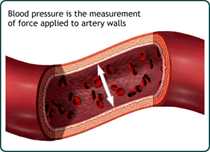
May is National Blood Pressure Education Month.About 1 in 3 U.S. adults—an estimated 68 million—have high blood pressure, which increases the risk for heart disease and stroke, two of the leading causes of death in the United States. High blood pressure is called the "silent killer" because it often has no warning signs or symptoms, and many people don't realize they have it. That's why it's important to get your blood pressure checked regularly. Inform your readers that this “silent killer” can be stopped! They can take steps to prevent high blood pressure, or control it through treatment.
The Million HeartsTM initiative aims to prevent a million heart attacks and strokes, in part by making it easier for Americans to control their blood pressure. The initiative encourages the health care community and individuals to focus on the ABCS:
The Million HeartsTM initiative aims to prevent a million heart attacks and strokes, in part by making it easier for Americans to control their blood pressure. The initiative encourages the health care community and individuals to focus on the ABCS:
- Appropriate Aspirin therapy
- Blood pressure control
- Cholesterol management
- Smoking cessation (quit smoking)
Other behaviors that contribute to overall health are also encouraged:
- Exercise regularly.
- Eat a healthy diet.
- Maintain a healthy weight.
- Prevent or control diabetes.
- Limit your alcohol intake (fewer than two drinks per day for men, or one drink per day for women).
Related Links:
Do your readers know about the CDC’s National Asthma Control Program?
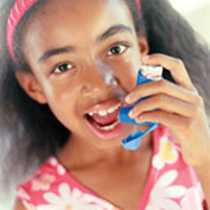
Asthma, a disease that affects the lungs, is one of the most common long-term diseases of children and adults. It causes repeated episodes of wheezing, breathlessness, chest tightness, and night time or early morning coughing. CDC’s National Asthma Control Program helps Americans living with asthma achieve better health and improved quality of life while reducing the overall hardship that asthma creates for families, employers, schools, the healthcare system, and communities.
CDC’s National Asthma Control Program is a resource for people living with asthma. The program:
- Collects information and follows trends related to asthma.
- Funds programs that work in communities and nationwide to assist people living with asthma.
- Studies the impact of asthma programs and treatment measures and applies this data to re-invest in strategies to help Americans living with asthma.
Related Links:
Jun
Men's Health: Improve Your Health

Improving men's health starts at home with individuals and families taking steps to live safer and healthier lives. Here are a few facts: From January through September 2011, 78 percent of women aged 19–25 had a usual place for health care compared with 63 percent of men in the same age group. Furthermore, women (81 percent) were more likely to have had a doctor visit in the past year than men (56 percent) and the leading cause of death for men is heart disease.
There are numerous things your readers can do every day to improve their health and stay healthy. Here are a few tips that don't take a lot of time and cost very little. Encourage your readers to make healthy living a part of their daily routine.
- Get Enough Sleep: Insufficient sleep is associated with a number of chronic diseases and conditions, such as diabetes, cardiovascular disease, obesity, and depression. Also, insufficient sleep is responsible for motor vehicle and machinery-related accidents, causing substantial injury and disability each year. Adults should get 7-9 hours of sleep per night, according to the National Sleep Foundation.
- Be Smoke-Free: Don’t smoke and avoid secondhand smoke. Inhaling other people's smoke causes health problems similar to those of smokers. Quitting smoking has immediate and long-term benefits. Within 20 minutes after smoking that last cigarette, your body begins a series of changes that continue for years.
- Be Physically Active: Be active for at least 2½ hours a week. Include activities that raise your breathing and heart rates and that strengthen your muscles. You don't have to do it all at once. Spread your activity out during the week, and break it into smaller chunks of time during the day.
- Eat What Counts: Eat a variety of fruits and vegetables every day. Limit foods and drinks high in calories, sugar, salt, fat, and alcohol. Choose healthy snacks.
- Get Vaccinated: Some adults incorrectly assume that the vaccines they received as children will protect them for the rest of their lives.
For more information, visit:
Sickle Cell: Did You Know?

Sickle cell disease is a group of inherited red blood cell disorders. In sickle cell disease, red blood cells become hard and sticky and look like a C shaped farm tool called a "sickle." The sickle cells die early, which causes a constant shortage of red blood cells. When they travel through small blood vessels, they get stuck and clog the blood flow. Sickle cell disease affects an estimated 80,000 to 100,000 Americans.
Sickle cell disease affects people of many racial and ethnic groups. In the United States, 1 in 400 African-American newborns have the disease. Other people affected include Hispanics, people of Mediterranean and Middle Eastern descent, and Asians. In addition, more than 3 million people carry the gene that allows them to potentially pass the disease on to their children.
Regular health checkups with a primary care doctor can help prevent some serious problems. Babies from birth to age 1 should see a doctor every 2 to 3 months. Children ages 1 to 2 should see a doctor at least every 3 months. Children and adults ages 2 or older should see a doctor at least once every year. Common illnesses, like the flu, can quickly become dangerous for a child with sickle cell disease. The best defense is to take simple steps to help prevent infections.
Try to stay healthy by drinking 8 to 10 glasses of water every day and eat healthy food. Try not to get too hot, too cold, or too tired. Children can, and should, participate in physical activity to help stay healthy. However, it's important that they don't overdo it, rest when tired, and drink plenty of water.
For more information, visit:
Cancer Survivors

A person is considered a cancer survivor from the time of cancer diagnosis through the remainder of his or her life. The impact of cancer on family members, friends, and caregivers of survivors is also acknowledged as part of survivorship.
Due to advances in the early detection and treatment of cancer, people are living many years after a diagnosis. In January 2007, about 11.7 million people with a previous diagnosis of cancer were living in the United States. Approximately 66 percent of people diagnosed with cancer are expected to live at least five years after diagnosis.
Cancer survivors may face physical, emotional, social, spiritual, and financial challenges as a result of their cancer diagnosis and treatment. Public health professionals strive to address survivorship and quality of life issues such as the coordination of care, patient-provider communication, health promotion, support services, and fertility preservation. In light of these concerns, public health initiatives aimed at understanding and preventing secondary disease, recurrence, and the long-term effects of treatment are essential.
Cancer survivors are at greater risk for recurrence and for developing second cancers due to the effects of treatment, unhealthy lifestyle behaviors, underlying genetics, or risk factors that contributed to the first cancer. The following factors can help maintain health and improve survival and quality of life after a cancer diagnosis—
- Quitting Tobacco Use
- Being Active and Maintaining a Healthy Weight
- Discussing Follow-up Care with a Health Care Provider
For more information, visit:
Jul
World Hepatitis Day
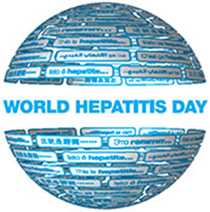
July 28th is World Hepatitis Day. Hepatitis B and hepatitis C can become chronic, life-long infections which can lead to liver cancer. Millions of Americans are living with chronic viral hepatitis, and many do not know they are infected. World Hepatitis Day aims to increase awareness and understanding of viral hepatitis and the diseases it causes. It provides an opportunity to strengthen prevention, screening, vaccination, and control of viral hepatitis and to coordinate a global response to hepatitis. Encourage your readers to learn more about hepatitis today.
Related Links
The Obesity Epidemic
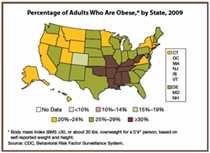
Percentage of Adults Who are Obese, by State, 2009
View larger map
More than one-third of U.S. adults (over 72 million people) and 17% of U.S. children are obese. In 1980–2008, obesity rates doubled for adults and tripled for children. During the past several decades, obesity rates for all population groups—regardless of age, sex, race/ethnicity, socioeconomic status, education level, or geographic region—have increased markedly. Recent reports show that substantial differences exist in obesity prevalence by race/ethnicity, and these differences vary by sex and age. For example, according to 2005–2008 data from the National Health and Nutrition Examination Survey, 51% of non-Hispanic black women aged 20 years or older were obese, compared with 43% of Mexican Americans and 33% of whites. Among females aged 2–19 years, 24% of non-Hispanic blacks, 19% of Mexican Americans, and 14% of whites were obese. Efforts are being made to reduce these disparities by focusing interventions on subgroups with high prevalence of obesity.
Obesity increases the risk of many health conditions, including the following:
- Coronary heart disease, stroke, and high blood pressure
- Type 2 diabetes
- Cancers, such as endometrial, breast, and colon cancer
- High total cholesterol or high levels of triglycerides
- Liver and gallbladder disease
- Sleep apnea and respiratory problems
- Degeneration of cartilage and underlying bone within a joint (osteoarthritis)
- Reproductive health complications such as infertility
- Mental health conditions
Related Links:
Who can help support breastfeeding?

Do your readers know one of the most highly effective preventive measures a mother can take to protect the health of her infant is to breastfeed? However, in the United States, though most mothers hope to breastfeed and 75% of babies start out being breastfed, only 15% are exclusively breastfed 6 months later. Additionally, rates are significantly lower for African-American infants.
The success rate among mothers who want to breastfeed can be greatly improved through active support from their families, friends, communities, clinicians, health care leaders, employers, and policymakers. Given the importance of breastfeeding for the health and well-being of mothers and children, it is critical that we take action across the country to support breastfeeding.
Let your readers know about who can help support breastfeeding:
- Mothers and their families. For example, mothers can talk to doctors and nurses about breastfeeding plans, and ask how to get help with breastfeeding. Ask about breastfeeding support when choosing a hospital. Join with other community members to encourage local hospitals to become
- Communities. A woman's community has many components, such as public health and other community-based programs, coalitions and organizations, schools and child care centers, businesses and industry, and the media. The extent to which each of these entities supports or discourages breastfeeding can be crucial to a success in breastfeeding.
- Health care. Nearly all births in the United States occur in hospital settings, but hospital practices and policies in maternity settings can undermine maternal and infant health by creating barriers to supporting a mother's decision to breastfeed.
- Employment. Employed women currently are less likely to initiate breastfeeding, and they tend to breastfeed for a shorter length of time than women who are not employed. Most employed mothers who are lactating must express milk at work for their children and should be provided with accommodations to do so.
Related Links
Aug
Physical Activity for Young People

Regular physical activity in childhood and adolescence improves strength and endurance, helps build healthy bones and muscles, helps control weight, reduces anxiety and stress, increases self-esteem, and may improve blood pressure and cholesterol levels. The U.S. Department of Health and Human Services recommends that young people aged 6–17 years participate in at least 60 minutes of physical activity daily.
Schools have an important role in promoting physical activity among young people. Research shows that students who earn mostly As are almost twice as likely to report regular physical activity than students who receive mostly Ds and Fs. Schools can promote physical activity through comprehensive school physical activity programs, including recess, classroom-based physical activity, intramural physical activity clubs, interscholastic sports, and physical education. Schools should also ensure that physical education is provided to all students in all grades and is taught by qualified teachers. Schools can also work with community organizations to provide out-of-school-time physical activity programs and share physical activity facilities.
Regular physical activity can benefit younger people by helping build and maintain healthy bones and muscles. It can help reduce the risk of developing obesity and chronic diseases, such as diabetes, cardiovascular disease, and colon cancer. It can reduce feelings of depression and anxiety and promotes psychological well-being. It also may help improve students’ academic performance.
Remember, participation in physical activity declines as young people age. So stay active!!!
For more information and free, downloadable resources, visit:
- CDC Healthy Youth
- School Health: Physical Activity Facts
- 2009 National Youth Risk Behavior Survey: Health-Risk Behaviors and Academic Achievement [1.2 MB]
- Video: Active Children and Adolescents
- Youth Physical Activity Guidelines Toolkit
- School Health Guidelines to Promote Healthy Eating and Physical Activity
- The Association Between School-Based Physical Activity, Including Physical Education, and Academic Performance [309 KB]
Being the Best Girlfriend a Friend Can Ask For!

Being girlfriends is a choice. Being healthy is a lifestyle. You’ve been through it all, and your girlfriends have traveled the journey with you. Continue the journey, and make health and safety that “other” supportive friend that helps you stay on top of things. Be a healthy girlfriend, and help a girlfriend live a safer and healthier life. Below are a few tips to help you stay focused on being the best you can be for yourself and your girlfriends.
Eat healthy at your gatherings.- Whether you’re gathered at home, book club, a birthday celebration, or a girls’ night out, make healthy choices in what you eat and drink. Keep the conversation going and the food rich in fruits and vegetables. A healthy weight contributes to good health now and as you age.
- Regular physical activity is important for good health, and it's especially important if you're trying to lose weight or to maintain a healthy weight. Adults should be active for at least 2½ hours a week. Talk and enjoy each other’s company while you walk, bowl, swim, dance, play tennis, and more.
- A friend with a chronic illness, abusive relationship, mental illness, or caregiving issues may lead a complicated life for a period of time. Do what you can to be supportive, and recognize that it may be challenging for you and your friend. If your friend is fearful about getting health care, offer to go with her.
- If your girlfriend is not taking care of her or her family’s health, is being careless, or is putting herself or others at risk, let her know, or tell someone who can help. Realize that she may need professional help; don’t try to be something you’re not. Help her get the help she needs when appropriate.
- Drinking excessive alcohol and smoking can hurt you and others. Drinking alcohol can increase the risk for unintentional injury and other problems. Both smoking and inhaling secondhand smoke are harmful.
- Get exams and screenings, vaccinations, and other health care you need. Manage stress from work, children, marriage, commuting, and life! Get enough sleep. Lower your risk for injury and disease. Take steps to live a healthier life
Related Links:
Sep
Be heart smart! High blood pressure is preventable and controllable

High blood pressure is a leading risk factor for heart disease and stroke, the first and fourth leading causes of death in the United States. Nearly 1 in 3 U.S. adults – 67 million people – has high blood pressure, and more than half – 36 million – don’t have it under control. High blood pressure costs the nation almost $131 billion a year in direct health care costs.
Adequate treatment and control of high blood pressure can reduce the risk of heart attacks and strokes, heart failure, and chronic kidney disease, and can save lives.
To learn more about blood pressure, visit www.cdc.gov/bloodpressure/.
Note: On September 4th, 2012 the CDC’s Vital Signs report will focus on getting blood pressure under control.
Related Links:
Be Ready! September is National Preparedness Month

Throughout September there will be activities across the country to promote emergency preparedness. More than 3,000 organizations – national, regional, and local public and private organizations – are supporting emergency preparedness efforts and encouraging all Americans to take action.
September 2012 marks the ninth annual National Preparedness Month, sponsored by the U.S. Department of Homeland Security. One goal of Homeland Security is to educate the public about how to prepare for emergencies, including natural disasters, mass casualties, biological and chemical threats, radiation emergencies, and terrorist attacks.
Your readers can join this month’s efforts by following these four steps:
The possibility of public health emergencies arising in the United States concerns many people in the wake of recent hurricanes, tsunamis, acts of terrorism, and the threat of pandemic influenza. Though some people feel it is impossible to be prepared for unexpected events, the truth is that taking preparedness actions helps people deal with disasters of all sorts much more effectively when they do occur. Encourage your readers to do their part,Related Links
September 28th, 2012 is World Rabies Day: Rabies is Preventable!
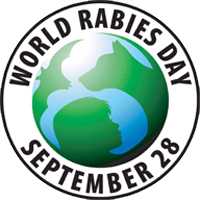
Rabies is a preventable viral disease of mammals most often transmitted through the bite of a rabid animal. The vast majority of rabies cases reported to the CDC each year occur in wild animals like raccoons, skunks, bats, and foxes.
September 28 is World Rabies Day, a global health observance that seeks to raise awareness about rabies and enhance prevention and control efforts. Co-sponsored by CDC and the Alliance for Rabies Control since 2007, World Rabies Day has been celebrated in countries throughout the world, including the U.S.
World Rabies Day is an excellent time to take steps that can help prevent and control rabies, such as vaccinating pets including dogs and cats and providing education on how to avoid the animals that typically transmit rabies. For more information on what your readers can do, share the following website with your readers: http://www.cdc.gov/features/rabies/. To learn what events are taking place around the world and in your community, visit: http://www.worldrabiesday.org/EN/events.html.
Related Links
Oct
Breast Cancer Awareness Month
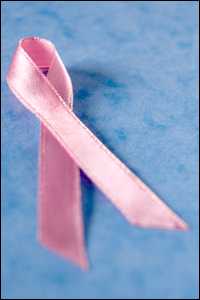
Not counting some kinds of skin cancer, breast cancer is the most common cancer in women in the United States. It is the most common cause of death from cancer among Hispanic women, and the second most common cause of death from cancer among white, black, Asian/Pacific Islander, and American Indian/Alaska Native women.
A mammogram is an X-ray of the breast. Mammograms are the best way to find breast cancer early when it is easier to treat and before it is big enough to feel or cause symptoms. Having regular mammograms can lower the risk of dying from breast cancer. Women between the ages of 40 and 49 should talk to their doctor about when to start getting mammograms. Women who are 50 or older should get a screening mammogram every two years.
CDC's National Breast and Cervical Cancer Early Detection Program (NBCCEDP) offers free or low-cost mammograms to women who qualify.
Related Links
What You Need to Know about Down Syndrome

October is Down Syndrome Awareness Month
Down syndrome is a common chromosomal condition affecting about 6,000 babies in the U.S. each year. The number of babies born with Down syndrome has been increasing in recent years, in part due to the growing number of pregnancies in older women. Because of better health care and services, people with Down syndrome are living longer and many lead productive lives well into adulthood. However, differences in survival still exist and are not fully understood.
Down syndrome is a condition in which a baby is born with an extra chromosome. This extra copy of genetic material changes the body’s and brain’s normal development and can cause mental and physical problems for the baby. Even though people with Down syndrome might have some physical and mental features in common, every baby born with Down syndrome is different and symptoms can range from mild to severe. Some examples of physical problems associated with Down syndrome include a birth defect of the heart or problems with the stomach, hearing, skeleton, intestines, thyroid, or eyes. People with Down syndrome usually have an IQ in the mild-to-moderate range of intellectual disabilities and typically have delayed language development and can have difficulties with physical coordination.
Babies and children with Down syndrome often benefit from special therapies that help to improve their physical and intellectual limitations, including speech therapy, occupational therapy, and physical therapy. Children with Down syndrome usually also benefit from extra help or attention in school. These services and improved care have contributed to full and productive living lasting well into adulthood for many people with Down syndrome.
Related Links
Bullying: Stop it before it starts

Bullying is a form of youth violence and can result in physical injury and social and emotional distress. Victimized youth are at increased risk for mental health problems, including depression and anxiety, psychosomatic complaints such as headaches, and poor school adjustment. Youth who bully others are at increased risk for substance use, academic problems, and violence later in adolescence and adulthood.
Bullying can also occur through technology, also known as electronic aggression or cyberbullying. Electronic ag-gression is bullying that occurs through e-mail, a chat room, instant messaging, a website, text messaging, or videos or pictures posted on websites or sent through cell phones.
The ultimate goal is to stop bullying before it starts. Research on preventing and addressing bullying is still developing. School-based bullying prevention programs are widely implemented, but have mixed evidence of effectiveness. There are some general youth violence prevention programs that seem promising for preventing bullying as well. Based on a review of the limited research on school-based bullying prevention, the following program ele¬ments are promising:
- Improving supervision of students
- Using school rules and behavior management tech¬niques in the classroom and throughout the school to detect and address bullying, providing consequences for bullying
- Having a whole school anti-bullying policy, and enforc¬ing that policy consistently
- Promoting cooperation among different professionals and between school staff and parents
Related Links
Nov
Are your readers Hurricane Ready?

CDC works 24/7 with state and local health departments to save lives and safeguard communities from public health threats. When states are prepared to detect or respond rapidly to threats, communities are better protected. CDC plays a critical role in preparing states because of its unique expertise in responding to infectious, occupational, or environmental incidents.
CDC suggests some the following basic steps to take to prepare for a storm, if you are under a watch or warning:
- Learn about your community's emergency plans, warning signals, evacuation routes, and locations of emergency shelters.
- Identify potential home hazards and know how to secure or protect them before the hurricane strikes. Be prepared to turn off electrical power when there is standing water, fallen power lines, or before you evacuate. Turn off gas and water supplies before you evacuate. Secure structurally unstable building materials.
- Buy a fire extinguisher and make sure your family knows where to find it and how to use it.
- Read the National Fire Protection Association's safety tips.
- Locate and secure your important papers, such as insurance policies, wills, licenses, stocks, etc.
- Post emergency phone numbers at every phone.
- Inform local authorities about any special needs, i.e., elderly or bedridden people, or anyone with a disability.
- Make plans to ensure your pet's safety.
Related Links
Enjoy your Turkey: Also Safety Tips for preparing your holiday meal

CDC estimates that each year roughly one out of six Americans (or 48 million people) get sick, 128,000 are hospitalized, and 3,000 die from foodborne diseases. Food safety is especially important as you prepare a holiday meal. Most foodborne outbreaks are local and many result from food being contaminated when it is being prepared or served by unwashed or improperly washed hands. CDC is a food safety partner with the United States Department of Agriculture (USDA), Food Safety and Inspection Service (FSIS), which is responsible for the safety of meat and poultry. Scientific evidence shows that preventing illness begins with the basics.
Help keep your readers informed and safe during this holiday season by sharing the following safety tips with them.
- Clean. Wash hands, cutting boards, utensils, and countertops.
- Separate. Keep raw meat, poultry, and seafood separate from ready-to-eat foods.
- Cook. Use a food thermometer to ensure that foods are cooked to a safe internal temperature: 145°F for whole meats (allowing the meat to rest for 3 minutes before carving or consuming), 160°F for ground meats, and 165°F for all poultry.
- Chill. Keep your refrigerator below 40°F, and refrigerate food that will spoil.
- Check your steps at http://www.foodsafety.gov/keep/basics/index.html
- Report suspected illness from food to your local health department.
- Don't prepare food for others if you have diarrhea or have been vomiting.
- Be especially careful when preparing food for children, pregnant women, those in poor health, and older adults.
Related Links
CDC? Do your readers know who we are and what we do?
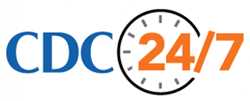
The Centers for Disease Control and Preventionis part of the health arm of the federal government, within the Department of Health and Human Services.
CDC works 24/7 keeping America safe from health, safety and security threats, both foreign and domestic. Whether diseases start at home or abroad, are chronic or acute, curable or preventable, human error or deliberate attack, CDC fights it and supports communities and citizens to prevent it. CDC is the nation’s health protection agency - saving lives, protecting people from health threats, and saving money through prevention.
We do this by tracking diseases and providing tools and information about what affects people’s health. We are the nation’s health response to outbreaks and emerging diseases that can strike at any time. We work closely with the state and local health departments to collaborate and offer expertise, information, and tools to protect people’s health. CDC monitors disease and the health of the nation, detects and investigates health problems, conducts research and implements actions proven to work, promotes healthy behaviors, fosters safe and healthful environments, and provides health leadership and training.
If your readers have a question related to CDC’s work or a specific disease, they can speak to a CDC representative by calling CDC-INFO at 1-800-232-4636 or by e-mail at cdcinfo@cdc.gov.
Related Links
CDC? Do your readers know who we are and what we do?
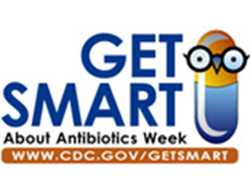
To bring attention to the growing global problem of antibiotic resistance, the Centers for Disease Control and Prevention (CDC) will observe its Get Smart About Antibiotics Week, November 12-18, 2012. The national campaign highlights the coordinated efforts of CDC, state and local health departments, and non-profit and for-profit partners to educate people about the threat of antibiotic resistance and the importance of appropriate antibiotic use in both community and healthcare settings.
Inform your readers about CDC's Get Smart: Know When Antibiotics Work and Get Smart for Healthcare programs, which are specifically designed to educate consumers and healthcare providers about appropriate use of antibiotics. The week long campaign will emphasize the following:
- Antibiotic resistance is one of the world’s most pressing public health threats.
- Antibiotics are the most important tool we have to combat life-threatening bacterial diseases, but antibiotics can have side effects.
- Antibiotic overuse increases the development of drug-resistant germs.
- Patients, healthcare providers, hospital administrators and policy makers must work together to employ effective strategies for improving appropriate antibiotic use – ultimately improving medical care and saving lives.
Keep your readers informed about CDC efforts with a reminder that antibiotics cure bacterial infections, not viral infections such as colds or flu, most coughs and bronchitis, sore throats not caused by strep or runny noses.
Related Links
Dec
National Handwashing Awareness Week-Dec. 2nd-8th

National Handwashing Awareness Week is December 2 through 8. Handwashing is easy to do and it's one of the most effective ways to prevent the spread of many types of infection and illness in all settings—from your home and workplace to child care facilities and hospitals. Washing hands can help stop germs from spreading from one person to another and even throughout communities.
When should you wash your hands?
- Before, during, and after preparing food
- Before eating food
- Before and after caring for someone who is sick
- Before and after treating a cut or wound
- After using the toilet
- After changing diapers or cleaning up a child who has used the toilet
- After blowing your nose, coughing, or sneezing
- After touching an animal, animal feed, or animal waste
- After touching garbage
What is the right way to wash your hands?
- Wet your hands with clean running water (warm or cold) and apply soap.
- Rub your hands together to make a lather and scrub them well; be sure to scrub the backs of your hands, between your fingers, and under your nails.
- Continue rubbing your hands for at least 20 seconds. Need a timer? Hum the "Happy Birthday" song from beginning to end twice.
- Rinse your hands well under running water.
- Dry your hands using a clean towel or air dry.
Washing hands with soap and water is the best way to reduce the number of germs on them. If soap and water are not available, use an alcohol-based hand sanitizer that contains at least 60% alcohol. Alcohol-based hand sanitizers can quickly reduce the number of germs on hands in some situations, but sanitizers do not eliminate all types of germs.
Related Links

Give the Gift of Health and Safety:
Holiday Tips
The holidays are a time to celebrate, give thanks, and reflect. They are also a time to pay special attention to your health. Here are a few holiday tips to follow this holiday season:
- Wash hands often to keep yourself from spreading germs and getting sick. Wash your hands with soap and clean running water for at least 20 seconds.
- Bundle up to stay dry and warm. Wear appropriate outdoor clothing: layers of light, warm clothing; mittens, hats, scarves, and waterproof boots.
- Manage stress. Don't over-commit yourself and prevent holiday anxiety and pressure. Get enough sleep.
- Don't drink and drive or let others drink and drive. Whenever anyone drives drunk, they put everyone on the road in danger.
- Be smoke-free. Avoid smoking and secondhand smoke. There is NO safe amount of tobacco or secondhand smoke. Breathing even a little secondhand smoke can be dangerous.
- Fasten seat belts while driving or riding in a motor vehicle. Always buckle your child in the car using a child safety seat, booster seat, or seat belt according to his/her height, weight, and age. Use a seat belt on every trip, no matter how short the trip.
- Get exams and screenings. Ask what exams you need and when to get them. Update your personal and family history.
- Get your vaccinations, which help prevent diseases and save lives.
- Monitor the children. Keep potentially dangerous toys, food, drinks, household items, and other objects out of kids' reach. Dress warmly for outdoor activities. Develop and reinforce rules about acceptable and safe behaviors including electronic media.
- Practice fire safety. Most residential fires occur during the winter months, so be careful to never leave fireplaces, space heaters, stoves, or candles unattended. Have an emergency plan and practice it regularly.
- Prepare food safely. Remember these simple steps: wash hands and surfaces often, avoid cross-contamination, cook foods to proper temperatures, and refrigerate promptly.
- Eat healthy, and get moving. Eat fruits and vegetables. Limit your portion sizes and foods high in fat and sugar. Be active for at least 2½ hours a week and help kids and teens be active for at least 1 hour a day.
Related Links
New Year, New You!

The New Year has long been a time for reflection on the personal changes we want to make as we look forward to a year of healthy possibilities. Health-related goals are popular New Year's resolutions, but sometimes we may not know where to begin. Below, you'll find ways to get and keep a healthy you, healthy family, healthy home, healthy community, and healthy workplace. Take time to make a healthy lifestyle your resolution.
- Make healthy food choices. Grab a healthy snack such as fruit, nuts, or low-fat cheese.
- Be active. Try simple things such as taking the stairs instead of the elevator. Be active for at least 2 ½ hours a week.
- Protect yourself from injury or disease by wearing a helmet, sunscreen, or insect repellent when necessary.
- Make an appointment for a check-up, vaccination, or screening. Know where to go for careif you do not have health insurance.
- Wash your hands often with soap and water. If soap and water are not available, use an alcohol-based hand sanitizer.
- Be smoke-free.If you think you're ready to quit, call 1-800-QUIT-NOW for free counseling.
- Get enough sleep. Remember that sleep is a necessity, not a luxury.
- Learn health tips that take 5 minutes or less.
Learn more about Healthy Living.
Error processing SSI file
- Page last reviewed: January 13, 2014
- Page last updated: January 13, 2014
- Content source:
Error processing SSI file


 ShareCompartir
ShareCompartir